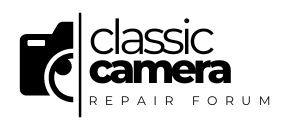
If one is a complete novice at camera repair (or tinkering as I prefer to call it), this is the book to read. Not because it is the best but rather because it is the simplest. Most would be tinkerers quit after the first camera either because they only intend on fixing their beloved old camera the local shop will no longer touch or because their first effort ended up in a baggie. So simple here is good.
Section 1 (of 3) starts out with a description of the tools and materials required, then chapters 3 & 4 moves into common sense precautions and Do’s and Don’ts. In chapter five the study of theory begins as Tomosy gives excellent flowcharts of operating sequences of the various types of cameras: Rangefinder, SLR, etc. Chapters 6, 7 & 8 is spent on cleaning. If you are still awake after these three, chapters 9 & 10 describe some common problems and their solutions…finally. Chapter 11 & 12 present basic troubleshooting. One of my favorite chapters was number 13 where there is descriptions of simple test equipment one can make. Chapter 14 goes into the tinkerers biggest nightmare, finding parts.
Section 2, things finally start to get interesting as he uses representative cameras to show some basic design layouts. Mechanical SLR, Electronic SLR, P&S’s, mechanical rangefinders, etc. These are well worth studying then coming back to often in the first few weeks of screw turning. I cannot praise this section enough but can complain that it isn’t thorough or complete enough. Tomosy explains the sample cameras well and “nearly” has enough pictures..
Section 3 is similar to Section 2 only many more cameras and very little information on each, kind of an anorexic Section 2.
The Appendix’s give ok reference data. Nothing to brag about. Read them if the cleaning chapters didn’t do you in.
All in all, Book 1 is a good book but too short for such a huge subject.
